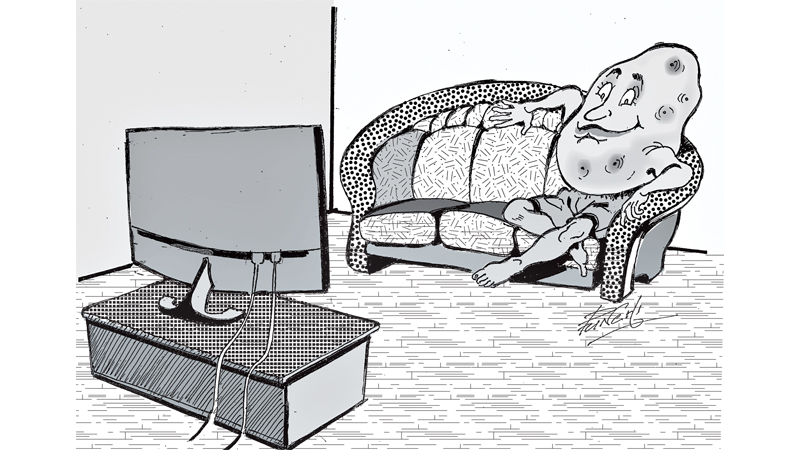The potato is a round white vegetable with a brown, red, or pale yellow skin that grows under the ground. The origin of potato is supposed to be Chile in South America, but we are not certain about it. It is not possible to explain how it got its name.
The Sinhala term ‘arthapal’ comes from the combination of the two words ‘earth’ and ‘apple’ which means the apple that grows in the earth. Today, potatoes are available in many parts of the world as it is a food of the common man. As there is a high percentage of starch in potatoes, it is supposed to appease hunger and add weight. However, doctors say that potatoes are bad for diabetic patients as they increase the sugar level.
Although the potato is a common food item, it is one of the most maligned and misunderstood vegetables. People believe that it is full of fat, starch and carbohydrates. They also think that potatoes have no protein and vitamins. Scientists have disproved such theories. You will have to eat at least one kilogram of potatoes to gain one kilo of weight.
A boiled medium size potato will have about 76 calories. This is fewer than the number of calories found in cheese, avocado, rice or bran flakes. Most people who eat potatoes do not think of calories or vitamins. However, according to a study by the US Department of Agriculture, potatoes are rich in riboflavin, iron and vitamin C.
Potatoes come in different sizes and shapes. Some of them are as small as nuts. However, if you walk into a market, you will find apple-sized potatoes. Unlike other vegetables, potatoes come in different colours such as gold, red, grey, blue and black. Some of them are not available at local markets.
Unlike Sri Lankans, Incas had many uses of potatoes. They placed raw slices of potato on broken arms and legs. They also rubbed a piece of potato on the head to cure headache. Incas used potatoes to prevent the occurrence of rheumatism and indigestion. They also knew the art of preserving potatoes for a long time.
Dainty dish
Incas had 52 varieties of potatoes called ‘papa’ meaning tuber. The Spaniards called the potato ‘turma de tierra’ or ‘truffle.’ For them, the potato was a dainty dish. However, when they introduced the potato to Europe, it became a victim of myths and slander.
Some of them thought that the potato was something evil because it was not grown from seed.
In the meantime, there was a popular belief that potatoes were responsible for the spread of leprosy, syphilis and scrofula. Some French scientists said that potatoes would destroy the soil. Even doctors advised people not to eat potatoes as they would cause many diseases. The humble potato had to wait for two centuries to be recognised by Europeans as a nutritional food. Potatoes were introduced to the United States way back in 1719 when a colony of Irish people settled in New Hampshire. At the beginning, the people thought potatoes shortened their lifespan. When rich people started eating potatoes, they became popular among the common people.
Today, most of the myths relating to potato eating have disappeared. Modern scientists recommend potatoes as an excellent source of nutrition. The US Department of Agriculture has said that a diet of whole milk and potatoes would supply almost all the nutrition to maintain the body.
Men, women and children eat potatoes without fear because they have fewer calories and they contain easily digestible proteins. If you walk into a tourist hotel, you will see how chefs hash, mash, mince, fry, steam, boil and roast potatoes.
Potato chips
People have invented many other food items using potatoes. Potato chips are quite popular in many countries. ‘Pomme de terre’ (apple of the earth) is one of the most popular potato dishes produced by the French. The Germans call potatoes ‘kartoffel’ or ‘truffle’ meaning ‘earth apple.’ They use potatoes lavishly for noodles, dumplings, pancakes and bread.
The Italians turn the potato into ‘gnocchi.’ The Spanish fill an omelette with ‘papas.’ The Greeks make a superb sauce called ‘skordalia’ with potatoes, olive oil, garlic and lemon.
Today, the humble potato has become the poor man’s food and the gourmet’s delight. The International Potato Centre (IPC) in Peru promotes the growth of potatoes. It is also trying to produce a perfect potato that will grow fast to satisfy the hunger of millions of people throughout the world. The IPC has already produced edible tubers called ‘super spuds.’
We are quite familiar with the term ‘couch potato’ referring to a person who takes little or no interest in household work or physical exercises and watches television for many hours. The term was coined in the United States from a pun on ‘boobtube’ as a slang expression for television. Someone given to continuous viewing of television was a ‘boobtuber.’
Robert Armstrong drew his most popular cartoon ‘Tuber’- a potato reclining on a couch watching television. Following this, a club called ‘The couch potatoes’ was formed and later registered as a trademark. One who spends a large amount of leisure or working time operating a computer is called a ‘mouse potato.’ The term was very much in vogue in the 1980s and 1990s.
Potato famine
After the failure of the potato crop, a potato famine occurred in Ireland in 1846. Many people died in the famine. The Irish Government’s failure or inability to alleviate conditions remained a longstanding source of bitterness.
Scientists have announced a set of guidelines for potato consumers. Here are some of them:
• Select potatoes that are well-formed, smooth, firm, with few eyes, no discolouration, cracks, bruises or soft spots
• Do not wash potatoes before storing because washing speeds up decay
• Do not store potatoes in the refrigerator
• Bake, boil or steam potatoes in their skin
• Do not soak peeled potatoes in cold water as nutrients will dissolve in the water






